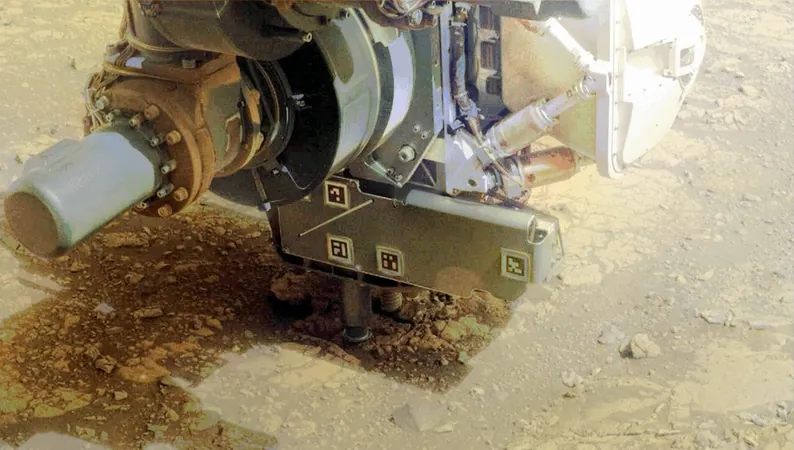
Unlocking Mars' Secrets: Perseverance Rover Digs into Mysterious Rock to Reveal Clues of Ancient Life
2025-06-30
Author: Liam
NASA's Perseverance rover is on an exhilarating quest to unearth the secrets of ancient Mars, grinding into rocky surfaces that could hold vital clues about the planet's past environment and its potential for habitability.
Earlier this month, the Perseverance rover unleashed its abrasion tool on a rocky outcrop whimsically dubbed "Kenmore." This procedure carefully stripped away the top layer of Martian rock, unveiling pristine samples for analysis, untouched by the ravages of time—from wind and radiation to dust storms.
A Rock Like No Other: Kenmore's Bumpy Journey
Described as a "weird, uncooperative rock" by Ken Farley, deputy project scientist for Perseverance, Kenmore proved to be a challenge during the analysis. Initially appearing suitable for sampling, the rock's vibrations and propensity to shed chunks during the grinding process raised concerns. "Fortunately, we managed to get just far enough below the surface to move forward with an analysis," Farley noted.
This recent engagement represents a significant pivot in the rover's mission, shifting from merely scouting to conducting intricate in-situ science. Perseverance now employs a cutting-edge abrading tool paired with the gaseous Dust Removal Tool (gDRT), utilizing nitrogen puffs to minimize contamination risks compared to earlier rover techniques.
High-Tech Analysis: The Tools of Discovery
Once the grinding was complete, Perseverance deployed its advanced scientific instruments to probe the freshly exposed rock. With the WATSON (Wide Angle Topographic Sensor for Operations and Engineering) imager snapping high-resolution photos and the SuperCam analyzing vaporized materials with laser pulses, researchers are diving deep into the rock's composition.
Cathy Quantin-Nataf, a member of the SuperCam team, revealed exciting findings: "The tailings showed us that this rock contains clay minerals, indicative of ancient Martian water," she stated, highlighting the presence of iron and magnesium. These insights are crucial for understanding Mars' wet history.
Evidence of Life: What Lies Beneath?
Perseverance doesn't stop there; it also employs SHERLOC (Scanning Habitable Environments with Raman & Luminescence for Organics & Chemicals) and PIXL (Planetary Instrument for X-ray Lithochemistry) to piece together the mineral content and hint at past water activity—possibly even microbial life. Notable discoveries included the presence of feldspar, a mineral familiar to Earth's crust, and manganese hydroxide, a first for the mission.
Farley added, "The data we collect from rocks like Kenmore will pave the way for future missions, helping them navigate and select targets more efficiently." This research could extensively inform whether these Martian materials could someday be used for fuel or as construction supplies for habitats.
Exploring Jezero Crater: Mars' Water World
Currently, Perseverance is stationed in Jezero Crater—a 28-mile-wide basin with a storied history as a river delta and lakebed. Scientists believe this region harbors some of the best-preserved records of Mars' watery past, making it the perfect hunting ground for biosignatures, or evidence of ancient life. Kenmore marks the 30th Martian rock meticulously studied by Perseverance, bringing us one step closer to unlocking the mysteries of our red neighbor.









 Brasil (PT)
Brasil (PT)
 Canada (EN)
Canada (EN)
 Chile (ES)
Chile (ES)
 Česko (CS)
Česko (CS)
 대한민국 (KO)
대한민국 (KO)
 España (ES)
España (ES)
 France (FR)
France (FR)
 Hong Kong (EN)
Hong Kong (EN)
 Italia (IT)
Italia (IT)
 日本 (JA)
日本 (JA)
 Magyarország (HU)
Magyarország (HU)
 Norge (NO)
Norge (NO)
 Polska (PL)
Polska (PL)
 Schweiz (DE)
Schweiz (DE)
 Singapore (EN)
Singapore (EN)
 Sverige (SV)
Sverige (SV)
 Suomi (FI)
Suomi (FI)
 Türkiye (TR)
Türkiye (TR)
 الإمارات العربية المتحدة (AR)
الإمارات العربية المتحدة (AR)